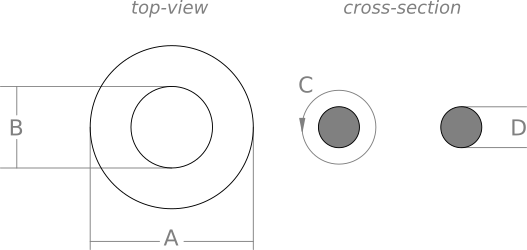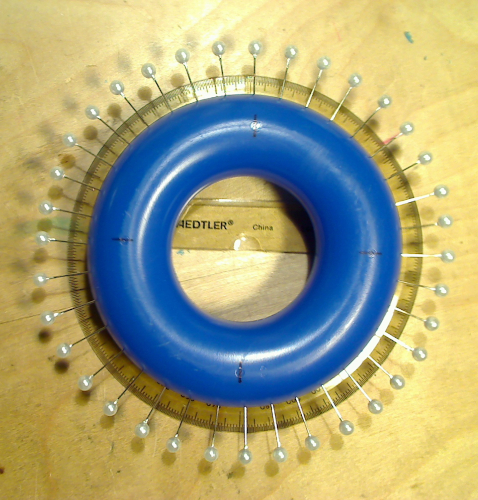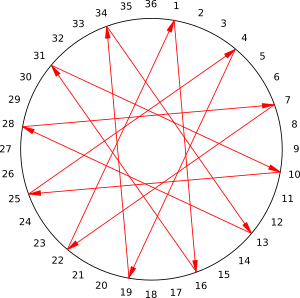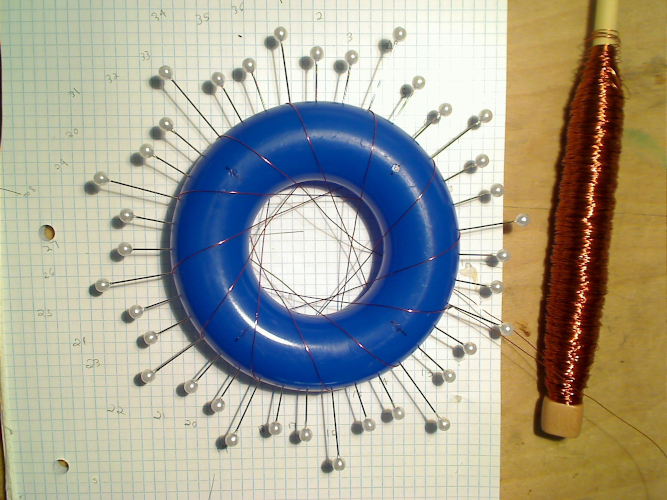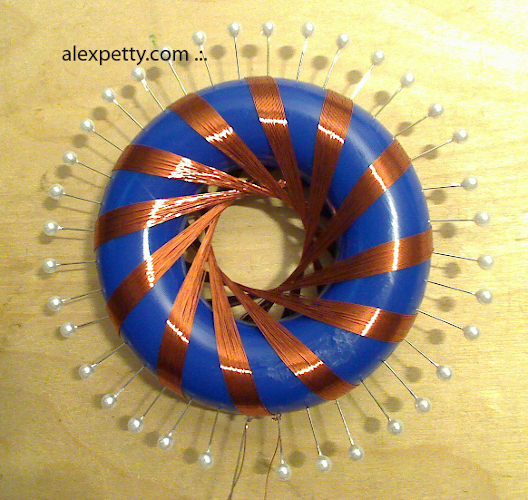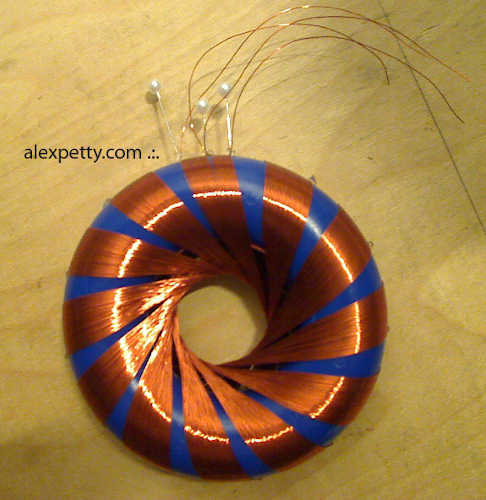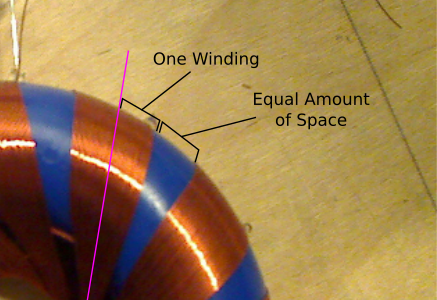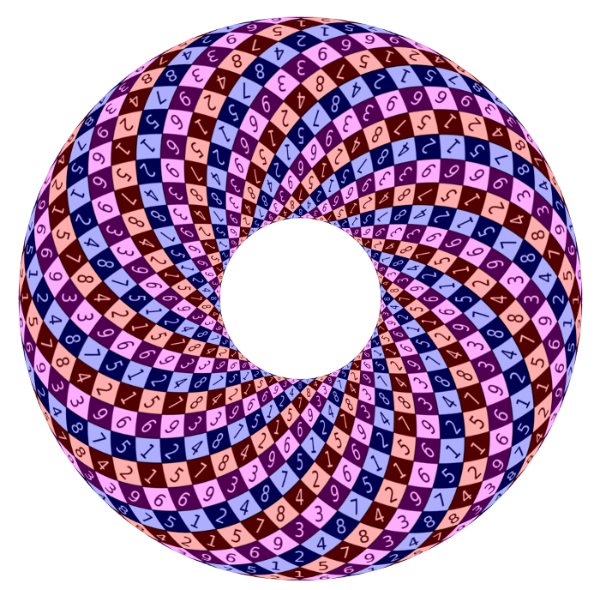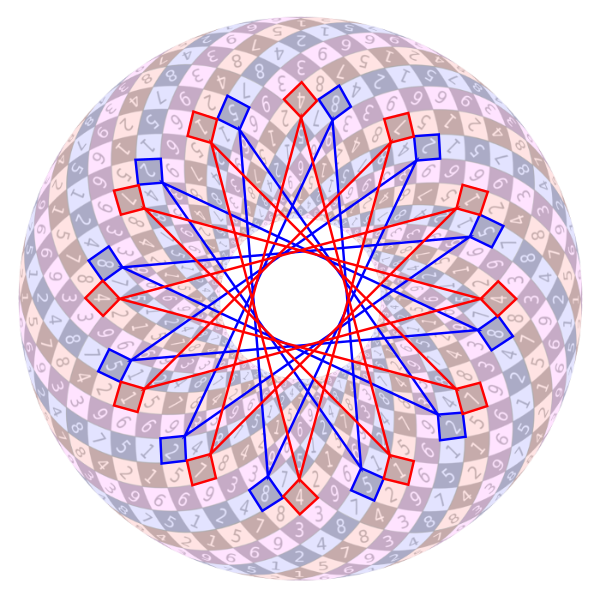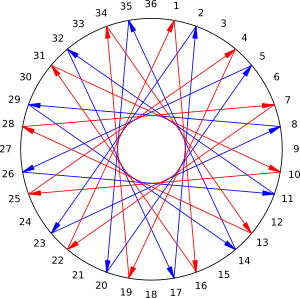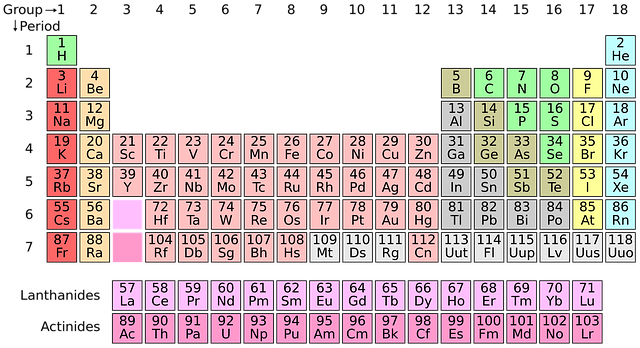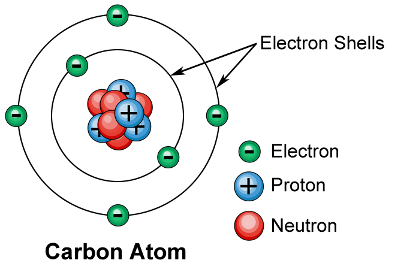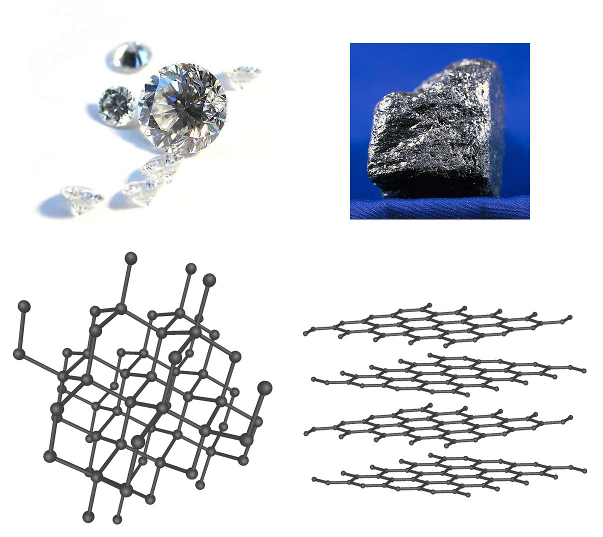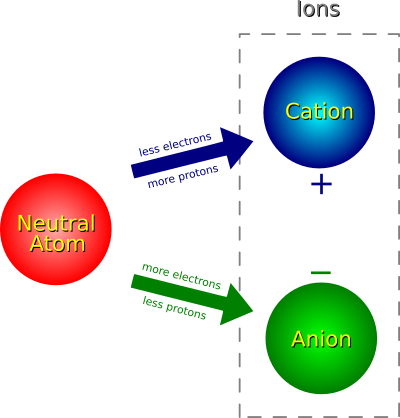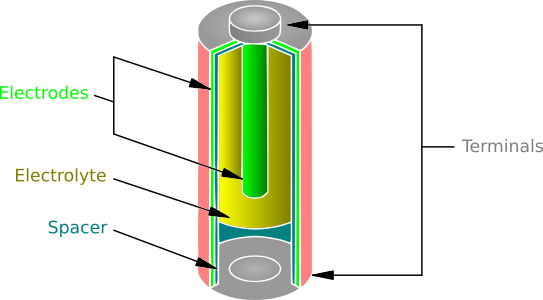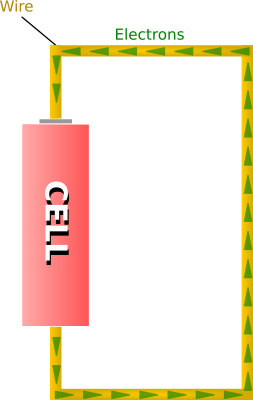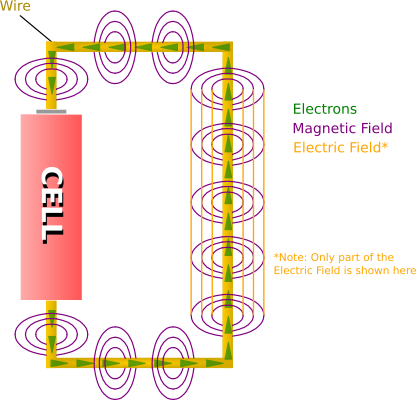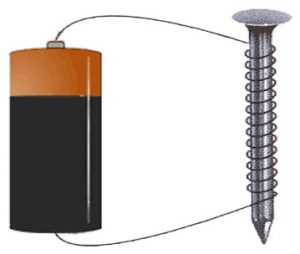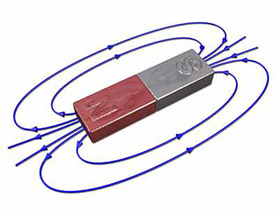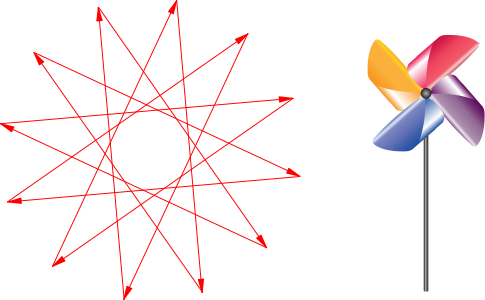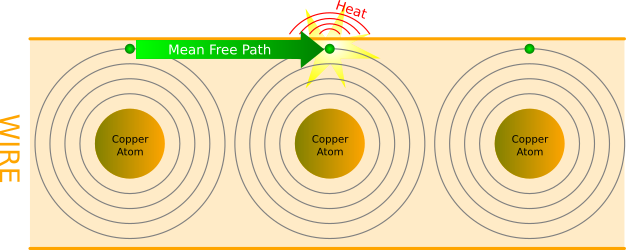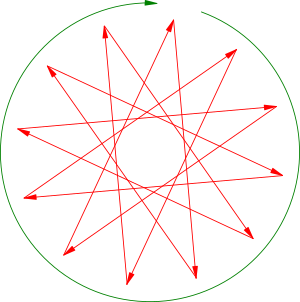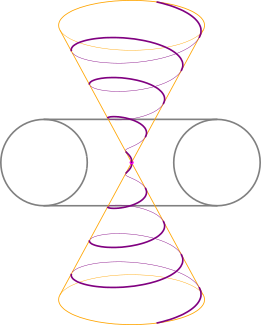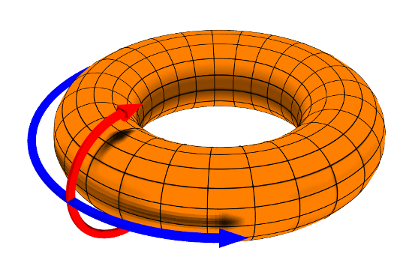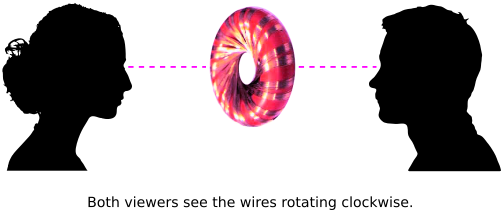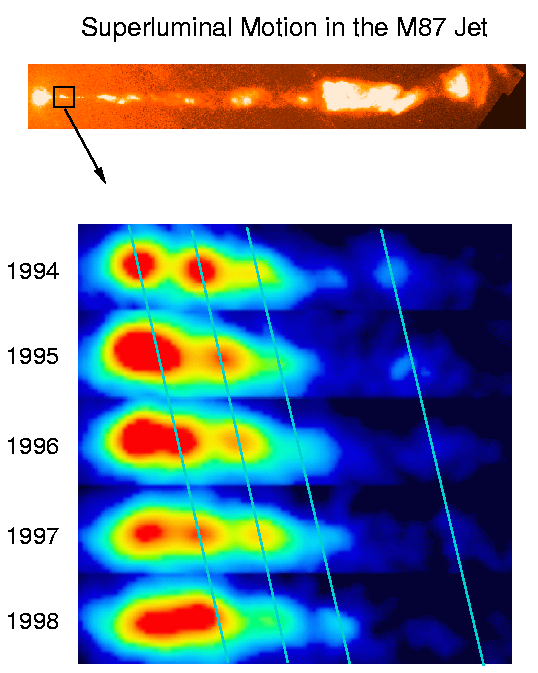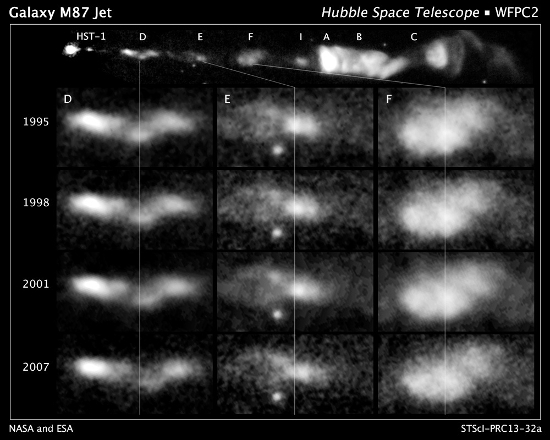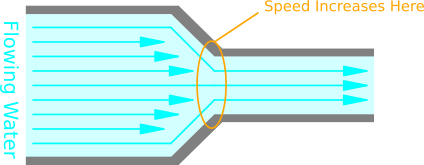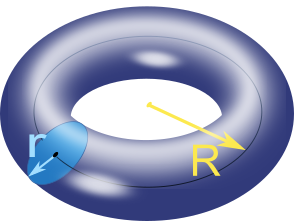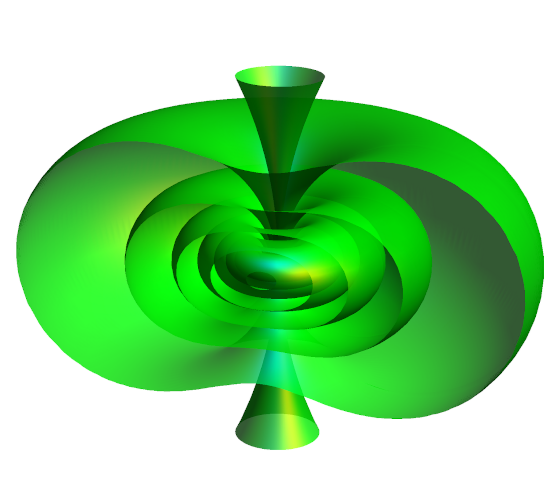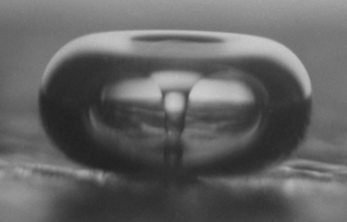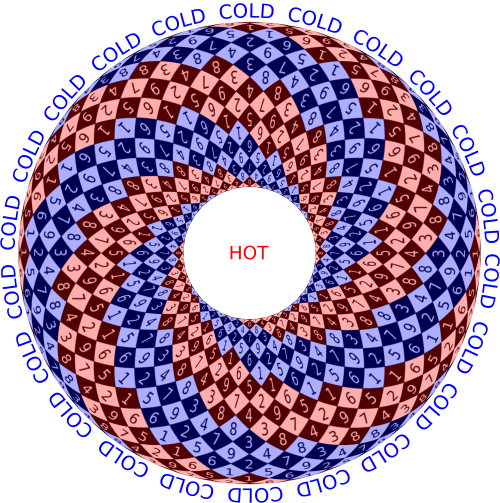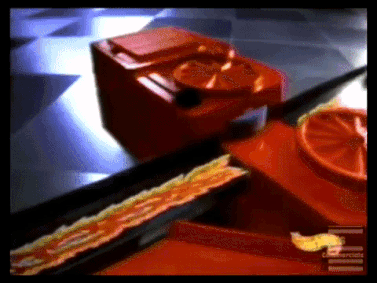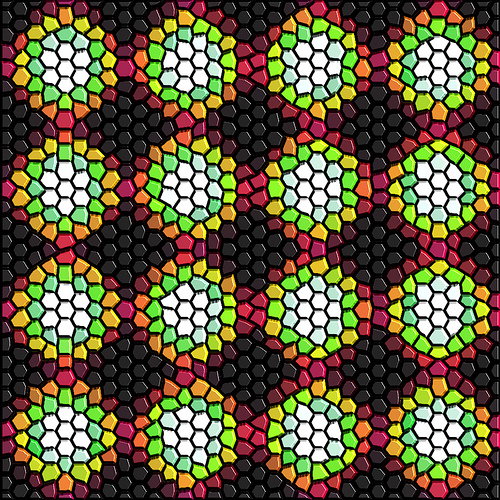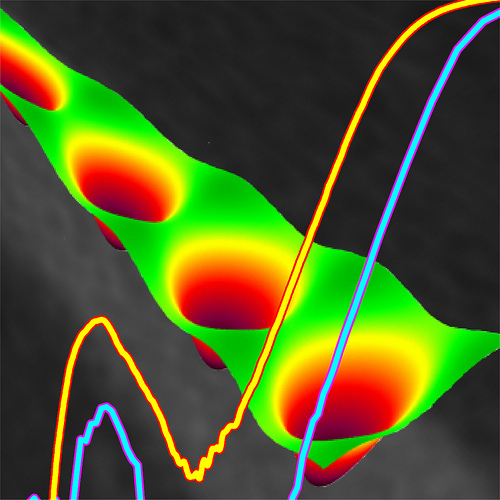Back • Return Home
The Flux Thruster
This article will apply much of the mathematics given within the previous two articles (The Universe: A Play In Four Acts and It's Vortices! Vortices All The Way Down!) to "electromagnetism". This will give us the tools needed to create technologies based off of it. Many useful resources are quoted and/or linked throughout. Please feel free to skip over them if they do not interest you. If something does not make sense the first time around, skim those parts and come back to them later. Information further into the document may help it to become more clear.
Contents
• Part 1: How To Make & Power A Flux Thruster
• Part 2: Commonly Accepted Scientific Models Made Simple
• Part 3: Theoretical Foundations For The Structure & Function of The Flux Thruster
• Part 4: Summary of Part 3
• Conclusion: Freedom for All
Part 1: How To Make & Power A Flux Thruster
WARNING: This information is shared for research purposes only. If you decide to experiment with it, you are responsible for your own decisions. There are very real (and potentially lethal) dangers that can occur when experimenting. Please use proper safety precautions and seek out the help of those with more experience in a given area whenever necessary.
This section assumes a passing familarity with basic electrical concepts. Please skip to Part 2 if you are not interested in the details of how a simple Flux Thruster is made.
While there are an increasing number of variants out there, we are only going to focus on the original Flux Thruster design (based off of the instructions of Bill Ramsay), as it has features that are very important for understanding the principles that lie behind it...
First, we need a form to wind our coil on. It must be a ring-shape and can only be made of certain materials (something that is generally "non-conductive", like paper, plastic, etc.). The Fisher Price company produces a toy called "Rock-a-Stack" which retails for ~$7. It is a series of plastic rings that comes with a stand to hold them. While they are not of the most ideal proportions, they are fairly easy to obtain and sufficient enough for producing some of the effects that we are looking for.
Photo Credit: Fisher Price
From the smallest-to-largest, the approximate measurements of these rings (given in inches) are:
|
A |
B |
C |
D |
| Red |
3.5" |
1.5" |
3.2" |
0.94" |
| Orange |
3.8" |
1.7" |
3.38" |
1.0" |
| Yellow |
4.13" |
1.8" |
3.6" |
1.06" |
| Green |
4.5" |
2.06" |
3.8" |
1.1" |
| Blue |
4.8" |
2.25" |
3.9" |
1.1" |
Whichever ring and wire size that we choose will determine the amount of wire that we need. For example, using a wire with a thickness of 24 AWG, the yellow ring will require ~79 feet of wire to wind (depending on the number of times that we wrap it around). We will probably need to separate this length of wire from its spool and wind it onto something thinner, like a wooden dowel. This is because it has to be able to fit through the hole of the plastic ring!
Next, we must prepare the ring for winding. We can use a razor to carefully remove any raised lettering, and scuff up its surface with some fine-grit sandpaper in order to give it some grip so that the wire does not slide around while we wrap it. If the plastic ring is particularly flimsy, we can also cut it open, pack it with foam, and glue it back together to make it more sturdy.
Then, we must make a pattern that will guide our wire placement. Take a piece of paper, a pencil, a ruler, a drafting compass, and a protractor. Use these tools to draw a circle the same size as the outside of our plastic torus and divide it up into 10-degree increments (or 36 parts) like so:
Taking a set of ballhead pins (like the kind used for sewing), we can use this template to place them along the outside edge of the plastic torus at regular intervals:
Photo Credit: Alex Petty
The numbers represent the spaces between the pins and will help us to wrap the wire into a star-shaped pattern:
This shape is achieved by a kind of weaving action. Wrap the wire around the top of the ring and into the hole, coming out around the outside at a space directly across from the previous. As we do this, we make the number sequence 1, 16, 31, 10, 25, 4, 19, 34, 13, 28, 7, 22, repeat. We should end up with something that looks like this:
Photo Credit: Alex Petty
We can extend the pins (like in the above image) to help us keep track of where we are in the sequence. We just have to take care that they don't fall out! We will repeat this entire process another 11 times (12 times in total), until we have the following:
Photo Credit: Alex Petty
This is one winding of The Flux Thruster. However, The Flux Thruster has two of them. To make the other, we will do the same kind of process with the number sequence 2, 23, 8, 29, 14, 35, 20, 5, 26, 11, 32, 17, repeat:
Again, after 12 repetitions we end up with a completed Flux Thruster, and can remove all of the pins. Glue or tape the wires in place as necessary:
Photo Credit: Alex Petty
The extra spaces that we have not touched are of equal width to each winding:
They are intentional. Nothing should be put there (i.e.: the wires should not cover the entire surface)!
If these instructions alone are not enough for understanding how to make a Flux Thruster, an Internet search for "How To Wind A Rodin Coil" will often bring up relevant material. This helpful video by TheRealVerbz2 is a good example.
You might be wondering where exactly this design came from, and how it is related to the mathematics. Let's take a pole-view of The ABHA Torus with The Doubling-Halving Circuits and The Gap Spaces highlighted:
Connecting together all of The Doubling Circuits (in red) gives one winding, while connecting together all of The Halving Circuits (in blue) gives the other winding. The spaces that we did not touch are The Gap Spaces (in magenta).
This also helps us to understand the general pattern used in powering The Flux Thruster. We need to send two electric pulses, one on each winding, in opposite directions:
In other words, while there is a DC pulse traveling clockwise on the first winding (marked in red), there is another DC pulse traveling counter-clockwise on the second winding (marked in blue). The opposite occurs with the next pair of pulses, and then there is a pause of rest. We will call this The Activation Sequence.
Overall, The Activation Sequence is like a heartbeat (da-Dum, pause, da-Dum, pause, da-Dum, pause, and so on). [When a circuit is designed for achieving this, we will update this page. It seems possible to use something like a metronome or pacemaker circuit to do this, such as the one described here.]
Part 2: Commonly Accepted Scientific Models Made Simple
In order to explain the theoretical background for the structure and function of The Flux Thruster, we must first lay out a very basic scientific foundation. We will try to make all of this as simple and as brief as possible...
All "matter" is made up of small units called "atoms". The different kinds of atoms that we have found are given their own names (such as "Hydrogen", "Oxygen", "Carbon", etc.). They are organized on a chart called a "periodic table". There are many kinds of "periodic tables", but this one is fairly standard:
The letters within each box are the name of that kind of atom. For example, "Au" means "Gold" (from the Latin "aurum"). It is called a "periodic table" because there are repeating, or "periodic", patterns throughout it. For example, the different kinds of atoms within each row and column have properties that are similar in some way.
Atoms connect together, or "bond", into clusters called "molecules". If there is only one type of atom bound together, it is called a "chemical element". If multiple types of atoms bond together, then it is a "chemical compound". Whenever we combine different kinds of atoms into a compound or seperate them into distinct atoms again, it is referred to as a "chemical reaction". There are different types of bonds and different kinds of chemical reactions that will either form them or break them.
We can go in the other direction too! The atom itself can be split into "sub-atomic particles" using devices called "particle accelerators". There are generally three "parts" to the atom, referred to as "electrons", "protons", and "neutrons". Different types of atoms have differing numbers of each sub-atomic particle. One way of thinking about them is that the protons and neutrons cluster together into a "nucleus", and the electrons orbit around them in "shells":
Photo Credit: American Welding Society
[This is called the "Rutherford-Bohr Model of the Atom". It is named after two scientists, Ernst Rutherford and Niels Bohr, who made discoveries that lie at the basis of this model.]
The ways in which atoms bond is controlled by their electrons. However, we can also turn one kind of atom into another by splitting apart its nucleus ("fission"), or fusing two nuclei together ("fusion"). These processes are referred to as "nuclear reactions" (or "transmutation"). They are usually accompanied by the release of a large amount of heat and light. A device which uses this phenomenon to run other machines is called a "reactor" (many of which even have a torus shape to their design, like the "tokamak").
There is actually quite a bit of variation between atoms themselves. For example, some atoms are "heavier" than others of the same kind. In other words, they have more neutrons, but the same number of protons and electrons. We call these "isotopes" (from the Greek "iso-" meaning "same", and "topos" meaning "place") because they exist in the same place on the periodic table. Their properties might differ from one another to some extent, but we do not give them separate names. We usually distinguish them from one another by adding a number to the end of their name, like "Carbon-12". This is called a "mass number" and it specifies how many protons and neutrons are within the isotope.
The ways in which atoms bond can also change their properties dramatically. For example, graphite (like that used in pencils) is soft and brittle, while diamond is hard and firm, yet both are made up of Carbon atoms! Graphite and diamond would be referred to as "allotropes" (from the Greek "allos-" meaning "other", and "tropos" meaning "form") because they are two different forms of the same chemical element.
Photo Credit: Itub
In the upper part of the above image, diamond is shown on the left and graphite is shown on the right. Their corresponding "crystal structures" (i.e.: the geometric patterns which describe how the atoms bond together to form that substance) are given underneath them.
Changing the bonds within compounds can change their properties as well. For example, water (which is a chemical compound of Hydrogen and Oxygen atoms) can take many different forms. It can be a solid (like ice), a liquid (like rain), or a gas (like steam). Solids, liquids, and gases are referred to as different "phases" or "states" of matter. To change from one type into another is called a "phase transition", and it is usually done by increasing and decreasing temperature and/or pressure:
Moving to the right on the above chart can be thought of as an increase in heat ("hotter"), while moving to the left would be a decrease in heat ("colder"). Further, while the elements within the compound might not change, the pattern of the bonds within it are changing (e.g.: they are lengthening or becoming more "tenuous" as heat increases). This is what gives the different states of matter their distinct properties. For example, when it is cold enough, water molecules "crystallize" into solids. These "crystals" of ice can have a specific shape, but they can also melt into a liquid that is "amorphous" (i.e.: without a specific shape), like when liquid water takes on the shape of its container. These different properties are due to the bonds between the water molecules changing.
There is another state of matter listed in the chart above that we have not yet covered: "Plasma"
A "plasma" is when the atoms that make up a gas either have more electrons than protons ("anion"), or less electrons than protons ("cation"). These are collectively referred to as "ions":
Different kinds of chemical reactions can produce ions. A familiar example is that of a "cell" or "battery". [Technically, a "battery" is a collection of "cells", but the terms are often used interchangeably. We will use the term "cell" here for sake of clarity.] Here is a cross section of a simple cell:
There are two metal caps called "terminals". Each of these terminals is connected to a different substance. These two substances are called "electrodes". In between the two electrodes is a "spacer" that separates them, and a paste made of several different chemical compounds. This paste is called an "electrolyte". The electrolyte causes a chemical reaction in each of the electrodes. One of the electrodes (called the "anode") combines with ions in the electrolyte to release electrons from the atoms that make it up, and the other (called the "cathode"), starts to absorb those electrons.
If we connect the ends of a copper wire to each terminal, then we form a "circuit". The electrons will flow from one terminal to the other through the wire. This is because the Copper wire is a "conductor" (i.e.: it can "conduct" or act as a channel for the movement of electrons). [More specifically, we would say that electrons within the outermost shell (or "valance band") of each Copper atom that makes up the wire are easily moved, and they will hop from atom-to-atom whenever they are "induced" or made to do so. The speed at which they do this is called "drift velocity".]
We will use an analogy to help clarify: Electrons are like water and the wire is like a pipe. The cell is producing a kind of pressure (called "voltage") and the electrons flow along through the wire in response, much like how the pressure on the water within the pipes of our home gets it to flow out of the faucet when we turn it on. The total number of electrons (called "charge") would be equivalent to the amount of water in the pipe, and the rate at which those electrons move (called "current"), would be equivalent to how quickly that amount of water is flowing.
Whenever the electrons within a wire are moving, then two "fields" are created in the area surrounding that wire. These are called the "electric field" (which is thought to move parallel to the wire), and the "magnetic field" (which is thought to move perpendicular to it in "loops of force"). [If we want to be more specific, the "magnetic field" is actually composed of two different aspects, the "B-field" and the "H-field".]
The electric and magnetic fields have a tendency to always appear together, so we often refer to them both as an "electromagnetic field" (or more generally, "electromagnetism"). [Note that the term "electricity" may refer to "electromagnetism" or just the "electric field" by itself.]
If we wrap the wire around a piece of Iron (like a nail), then we form an "electromagnet". It can be used to pick up other small pieces of Iron (such as paper clips):
Photo Credit: Carnegie STEM Girls
If the current is strong enough, the piece of Iron that the wire is wrapped upon will become "magnetized". In other words, it will act like an electromagnet even when the cell is removed. This is a "permanent magnet".
Photo Credit: National Mag Lab
The magnetic field is shown here in blue. The permanent magnet has two "poles", labeled "north" (or "N") and "south" (or "S").
We can also use electromagnetic fields in other ways. For example, we can use them to vibrate metal structures called "antennas". This produces "radio waves" that can then be received by other antennas. This allows us to transmit information at a distance by changing the pattern of vibrations. Here is a summary diagram:
Photo Credit: ExplainThatStuff
This concludes the necessary background information. Again, these summaries are highly simplified, and it is important to note that none of these models are to be taken as literal pictures of atoms and particles! They are just convenient ways to keep track of what we measure about various substances and the things that we can do with them. In fact, their ability to explain many phenomena is limited. However, despite these limitations, they can still be quite useful! We introduce them here because they are familar to many people, and they will help us to establish a common language for talking about things that are more subtle...
Part 3: Theoretical Foundations For The Structure & Function of The Flux Thruster
There are a couple of things to keep in mind throughout all of this:
1. At this stage, The Flux Thruster is only a "proof of concept", not a final product! Its purpose is to generally show what is possible. We will point out some of the applications of it as we describe the theory behind it. It will require further engineering in order to fulfill each application.
2. All of the features of The Flux Thruster (including its measurements and how it is powered) combine and interact in a particular way. This makes it a little tricky to present an explaination of it, as many things are occuring simultaneously.
• Feature #1: Pulsed DC
Currents can take on two different forms depending on how they are generated. There is "Alternating Current" (or "AC") and "Direct Current" (or "DC"). [Technically, there are a couple of other types, but we won't focus on them much here.]
As its name implies, Alternating Current "alternates" (i.e.: it moves back and forth). We DO NOT want this to happen within The Flux Thruster! We want the current to move in one direction only. Therefore, we will use Direct Current.
Likewise, we DO NOT want the current to be "continuous" (i.e.: continuing without pauses in a steady stream). So instead, we will pulse it. This is mainly for two reasons:
1. It helps overcome "resistance" (i.e.: opposition to the flow of current).
2. It helps create "resonance" (i.e.: when a small input that is applied in a specific way can generate a larger result).
• Feature #2: Bifilar (Two Windings)
Even though there are two windings or conductive pathways, the pulses on each one of them is moving in opposite directions (i.e.: towards one another). This is called Shearing:
Wires are often shielded from one another with some kind of non-conductive material (called "insulation"). This absorbs / blocks the current and keeps it from "shorting" (i.e.: when current moves from one part of the circuit to another unintentionally; it is a "short" because it makes the circuit shorter than it normally would be).
In combination, features #1 and #2 help produce what we will call Synchronized Electricity. In other words, the timing and movement of the pulsed DC makes it so that there is no shorting, even if our conductive pathways are two bare copper wires sitting right next to each other.
• Feature #3: 12-Pointed Star Pattern
Each winding also makes a 12-pointed star. This is called a Pinwheel Winding because it looks like a pinwheel:
One very special consequence of using a 12-pointed star is that it only ever crosses itself at 90-degrees:
This minimizes "crosstalk" (i.e.: when the fields around two parts of a circuit interfere with one another; in some ways it is similar to shorting). [There are also more "exotic" ways of interpreting the effects that features #2 and #3 produce, such as the generation of "scalar waves" (a concept from Tom Bearden), but we won't cover that in-depth here.]
Another important aspect of the 12-pointed star is that it helps us to give the winding the "least acute incline as possible". In other words, we want it to curve gradually rather than move straight up and down. Let's look at a cross-section of the torus to get an idea of it:
Generally, the theory behind resistance is that it is caused by the electrons crashing into each other as they move. Their impacts cause excess heat which makes the efficiency drop. This is a representation of what is happening inside of the wire:
We can use an analogy to help clarify: Imagine the electrons were marathon runners. It is harder to run when we are hot and tired, so much so that we might start running into the runners next to us when we are! This keeps everyone from being able to run.
The distance that a particle can move before it is bumps into another one is called its "mean free path". In this case, our conductive pathway is making what we will refer to as The Longest Mean Free Path of Least Resistance. We are trying to decrease resistance by lowering the likelihood of collisions.
If the resistance of a conductor drops low enough, we eventually end up with a "superconductor" (i.e.: a material that can move a current without resistance). Usually these are formed by chilling specific substances to very cold temperatures.
While temperature is a factor, the shape of our conductive pathway is much more important! Notice that a change in temperature can actually be thought of as a change in shape (e.g.: usually, cold makes things contract, while heat makes them expand). With more engineering, it is possible to make a "room-temperature superconductor" (i.e.: a material that stays superconductive at much higher temperatures). The Flux Thruster is demonstrating some of the principles behind it!
We will keep revisting this concept of superconductivity as we continue, but for now, there is one last thing that we want to point out about the 12-pointed star. It is "unicursal", meaning that it spirals around only to end up where it begins:
Therefore, features #1, #2, and #3 combine to make what we will call a Torsion B-Field. This is just a fancy way of saying that there are two counter-rotating magnetic fields:
This movement can be used in various ways to run generators and other devices. [As an aside, there is also some "fringe" information which attributes "anti-gravity" effects to certain configurations of counter-rotating magnetic fields.]
• Feature #4: Ring Shape
Because The Flux Thruster is a torus, the fields are concentrating in the center hole. If there is enough magnetism collected there, it can form a plasma. This phenomenon is called "pinch". [If we want to be fancy, we can use some terminology from fusion research in order to describe it. We would say that the "magnetic confinement" geometry is "poloidal" rather than "toroidal":
Photo Credit: DaveBurke
The "toroidal" direction is shown with a blue arrow. It is equivalent to our X-axis. The "poloidal" direction is shown with a red arrow. It is equivalent to our Y-axis. In other words, the magnetism is focused on the pole rather than within the ring itself.]
The ABHA Torus can be thought of as a macroscopic view of an atom [specifically an atom of Carbon-12], and features #1-4 of The Flux Thruster can help us to get a clearer picture of what is happening inside of it. There are two things to point out here:
1. On the most fundamental level, the "nucleus" is actually a hole. It only seems dense because it is tightly compressed. In other words, atoms are rings and systems of rings!
2. It shows us a few of the mechanisms behind the spin of electrons. It is hypothesized that the reason that electrons do not decay over time is because they are essentially superconducting rings! This is referred to as "persistent current". To quote the article "Physicists Measure Elusive 'Persistent Current' That Flows Forever" (PhysOrg):
Physicists at Yale University have made the first definitive measurements of "persistent current," a small but perpetual electric current that flows naturally through tiny rings of metal wire even without an external power source.
The team used nanoscale cantilevers, an entirely novel approach, to indirectly measure the current through changes in the magnetic force it produces as it flows through the ring. "They're essentially little floppy diving boards with the rings sitting on top," said team leader Jack Harris, associate professor of physics and applied physics at Yale. The findings appear in the October 9 issue of Science.
The counterintuitive current is the result of a quantum mechanical effect that influences how electrons travel through metals, and arises from the same kind of motion that allows the electrons inside an atom to orbit the nucleus forever. "These are ordinary, non-superconducting metal rings, which we typically think of as resistors," Harris said. "Yet these currents will flow forever, even in the absence of an applied voltage."
Although persistent current was first theorized decades ago, it is so faint and sensitive to its environment that physicists were unable to accurately measure it until now. It is not possible to measure the current with a traditional ammeter because it only flows within the tiny metal rings, which are about the same size as the wires used on computer chips.
Past experiments tried to indirectly measure persistent current via the magnetic field it produces (any current passing through a metal wire produces a magnetic field). They used extremely sensitive magnetometers known as superconducting quantum interference devices, or SQUIDs, but the results were inconsistent and even contradictory.
"SQUIDs had long been established as the tool used to measure extremely weak magnetic fields. It was extremely optimistic for us to think that a mechanical device could be more sensitive than a SQUID," Harris said.
The team used the cantilevers to detect changes in the magnetic field produced by the current as it changed direction in the aluminum rings. This new experimental setup allowed the team to make measurements a full order of magnitude more precise than any previous attempts. They also measured the persistent current over a wider range of temperature, ring size and magnetic field than ever before.
"These measurements could tell us something about how electrons behave in metals," Harris said, adding that the findings could lead to a better understanding of how qubits, used in quantum computing, are affected by their environment, as well as which metals could potentially be used as superconductors.
Authors of the paper include Ania Bleszynski-Jayich, William Shanks, Bruno Peaudecerf, Eran Ginossar, Leonid Glazman and Jack Harris (all of Yale University) and Felix von Oppen (Freie Universität Berlin).
The Flux Thruster is demonstrating "the source of the non-decaying spin of the electron"! We will have more to say upon this subject as we continue...
• Feature #5: Under-Over Pattern
The under-over pattern to the windings gives an asymmetry to the magnetic field. In other words, it is pushing it out of one side. [This is very similar to a "Halbach Array", which is a set of permanent magnets arranged in such a way as to cancel out the magnetism on one side of them.] This is easy to see when we look at another cross-section of the torus:
We often think of current as having polarity because it has direction. For example, this is why there are "positive" (+) and "negative" (-) terminals on a cell. Electrons flow from the negative terminal to the positive one.
A "magnetic monopole" (a magnet that is only "north" or "south", not both) is usually considered an "impossibility" because magnetism is thought to make only closed loops. [Although, there are other ways of approaching it now.]
Even if we were to try to split apart a permanent magnet in some way, it would just make a smaller magnet. We cannot give the magnetic field a polarity...or can we? There are two things to notice here:
1. One could argue that the electric and magnetic fields make a helix, rather than being 90-degrees from one another as it is normally taught. The magnetic field seems like it only makes loops around a circuit because we are taking cross-sections of the field whenever we measure it. Further, we can treat The Number Map as mapping out these fields! The 1-2-4-8-7-5 would be showing the dynamics of the electric field, while 3 and 6 would be showing the dynamics of the magnetic field. The same pattern applies no matter how we change the shape of the The Number Map. (Remember, we can roll it into a cylinder and/or a torus!)
2. Since we are giving the magnetism polarity by giving it direction like this, are we harnessing what might be called a "magnetic current"? Let's look at this more deeply for a moment...
There is a "handedness" [or "chirality"] to a helix:
If one looks carefully, the same is true of The Flux Thruster:
Therefore, should we expect one winding pattern to produce a predominance of "north pole magnetism", and the other to produce a predominance of "south pole magnetism"? We generally refer to these rays of magnetism as Positive Emanations because they "emanate" or ray out from the central hole. We will come back to this subject later...
Because of the combination of features (particularly #4 and #5), a stream of plasma will also eject out of one end of The Flux Thruster if the fields are made strong enough.
[We call this a Centroid Nozzle. A "centroid" is the center point of a solid geometry, and the pinch located at the centroid of the torus is acting like a nozzle. The spray of plasma coming out of this nozzle can be used to generate thrust, similar to how a rocket engine directs burning fuel, or "propellant", out of one end of it in order to make it lift off. This is called "jet propulsion".
The Flux Thruster can be engineered into a super efficient "plasma propulsion engine". This engine would not need to store fuel because it could turn the gases within the ambient environment into a plasma to use as a propellant, nor would it need extra sources of energy to generate enough electricity to make these plasmas because of its superconductive features. Therefore, it would not have limitations to the amount of thrust that it could produce, unlike conventional plasma propulsion.
In short, by concentrating magnetic "flux" and giving it direction, we can produce a jet of plasma that can be used as a thruster, hence the name "Flux Thruster". Again, there are "alternative" ways in which to look at how it may be used (such as building devices called "reactionless drives"), but we will not cover that here.]
There are also instances of this phenomenon occuring within Nature. For example, on the macro scale, there is thought to be a "supermassive black hole" at the center of each galaxy. They sometimes release observable streams of incredibly fast moving plasma called "superluminal jets". [The central portion of a galaxy can become illuminated by these jets and other kinds of "radiation". When this happens, it is referred to as an "active galactic nucleus" (or "AGN" for short).] The black hole at the center of galaxy M87 is a good example. To quote the article "'Superluminal' Motions In Astronomical Objects" by Michael Richmond:
Astronomers have known for some time that a small fraction of galaxies have peculiar "jets" extending from their very centers. [...] Jets, by themselves, are peculiar: why should matter and/or energy be ejected from the center of a galaxy? Why should it be squirted in such a narrow beam? But some of them become even more peculiar if you look at them over a period of time, using telescopes which can perceive very fine details.
This, for example, is a recent HST image of the jet in M87. Note that the jet is broken into knots:
Let's rotate our view for convenience so that the jet points to the right:
If you zoom in on an inner portion of the jet, you can see little blobs which appear to shoot out to the right over just a few years:
Another very good reference on this particular superluminal jet is "The Guide To Messier Objects". To quote a section out of it:
The galaxy has a jet of energetic plasma emanating from its core and extending at least 4,900 light years outwards. The jet consists of gaseous material expelled from the galaxy's nucleus and travels at relativistic speed. Observations with the Hubble Space Telescope in 1999 revealed that the jet was moving at four to six times the speed of light. The gas clouds have an apparent superluminal motion, which is likely an illusion caused by the fact that the jet is pointing in our direction. The discovery of such motion supports the theory that quasars, radio galaxies and BL Lacertae objects may all in fact be active galaxies, only seen from different perspectives.
This sequence of images, taken by the NASA/ESA Hubble Space Telescope over a period of 13 years, reveals changes in a black-hole-powered jet of hot gas in the giant elliptical galaxy M87. The observations show that the river of plasma, travelling at nearly the speed of light, may follow the spiral structure of the black hole's magnetic field, which astronomers think is coiled like a helix. The magnetic field is believed to arise from a spinning accretion disc of material around a black hole. Although the magnetic field cannot be seen, its presence is inferred by the confinement of the jet along a narrow cone emanating from the black hole. The visible portion of the jet extends for some 5000 light-years. M87 resides at the centre of the neighbouring Virgo cluster of roughly 2000 galaxies, located 50 million light-years away.
The images are part of a time-lapse movie that reveals changes in the jet from 1995 to 2007. They were taken by Hubble’s Advanced Camera for Surveys in 2006 and the Wide Field Planetary Camera 2 in 1995, 1998, 2001, and 2007. Image: NASA, ESA, E. Meyer, W. Sparks, J. Biretta, J. Anderson, S.T. Sohn, and R. van der Marel (STScI), C. Norman (Johns Hopkins University), and M. Nakamura (Academia Sinica)
[Bold text has been added for emphasis.]
...In short, The Flux Thruster is like the magnetic field inside a black hole and can produce a jet of plasma in a similar manner. We are starting to uncover the methods that allow galaxies to fly around in their orbits, literally! [As far as more "traditional" physics goes, what is known as the "Kerr-Newman metric" probably comes closest to these ideas by treating a black hole as a "rotating, charged mass".]
Interestingly, the mathematics that is used for describing black holes can also apply to certain types of superconductors! These are sometimes referred to as "holographic superconductors". The article "Inexplicable Superconductor Fractals Hint at Higher Universal Laws" by Brandon Keim (Wired) gives a very readable summary. We will quote it here in full:
What seemed to be flaws in the structure of a mystery metal may have given physicists a glimpse into as-yet-undiscovered laws of the universe.
The qualities of a high-temperature superconductor - a compound in which electrons obey the spooky laws of quantum physics, and flow in perfect synchrony, without friction - appear linked to the fractal arrangements of seemingly random oxygen atoms.
Those atoms weren't thought to matter, especially not in relation to the behavior of individual electrons, which exist at a scale thousands of times smaller. The findings, published Aug. 12 in Nature, are a physics equivalent of discovering a link between two utterly separate dimensions.
"We don't know the theory for this," said physicist Antonio Bianconi of Rome's Sapienza University. "We just make the experimental observation that the two worlds seem to interfere."
Unlike semiconductors, the metals on which modern electronics rely, superconductors allow electrons to pass through without resistance. Rather than bouncing haphazardly, the electrons' movements are perfectly synchronized. They flow like a fluid, but without viscosity.
For most of the 20th century, this was possible only in certain extremely pure metals at temperatures approaching absolute zero, cold enough to quench all motion but that of quantum particles, which interact with each other in ways that defy the classic laws of space and time.
Then, in the mid-1980s, physicists Karl Muller and Johannes Bednorz discovered a class of ceramic compounds in which superconductivity was possible at much higher temperatures. The temperatures were still hundreds of degrees Fahrenheit below zero, but it wasn't even thought possible.
Muller and Bednorz soon won a Nobel Prize, but subsequent decades and thousands of researchers have not yielded a theory of high-temperature superconductivity. "High temperatures should destroy the quantum phenomenon," said Bianconi, who decided to investigate another odd property of these materials: They're not quite regular. Oxygen atoms roam inside, and assume random positions as they freeze.
"Everyone was looking at these materials as ordered and homogeneous," said Bianconi. That is not the case - but neither, he found, was the position of oxygen atoms truly random. Instead, they assumed complex geometries, possessing a fractal form: A small part of the pattern resembles a larger part, which in turn resembles a larger part, and so on.
"Such fractals are ubiquitous elsewhere in nature," wrote Leiden University theoretical physicist Jan Zaanen in an accompanying commentary, but "it comes as a complete surprise that crystal defects can accomplish this feat."
If what Zaanen described as "surprisingly beautiful" patterns were all Bianconi found, the results would have been striking enough. But they appear to have a function.
In Bianconi's samples, larger fractals correlated with higher superconductivity temperatures. When the fractal disappeared at a distance of 180 micrometers, superconductivity appeared at 32 degrees Kelvin. When it vanished at 400 micrometers, conductivity went quantum at 42 degrees Kelvin.
At -384 degrees Fahrenheit, that's still plenty cold, but it's heading towards the truly high-temperature superconductivity that Bianconi describes as "the dream" of his field, making possible miniature supercomputers that run at everyday temperatures.
However, while the arrangement of oxygen atoms appears to influence the quantum behaviors of electrons, neither Bianconi nor Zaanen have any idea how that could be. That fractal arrangements are seen in so many other systems - from leaf patterns to stock market fluctuations to the frequency of earthquakes - suggests some sort of common underlying laws, but these remain speculative.
According to Zaanen, the closest mathematical description of superconductive behavior comes from something called "Anti de Sitter space / Conformal Field Theory correspondence," a subset of string theory that attempts to describe the physics of black holes.
That's a dramatic connection. But as Zaanen wrote, "This fractal defect structure is astonishing, and there is nothing in the textbooks even hinting at an explanation."
The way that the term "fractal" is used here is equivalent to "self-similar". Remember, The ABHA Torus is self-similar! This concept is key in scaling phenomena like superconductivity up and down in size. Again, think shape, not temperature or pressure! We will come back to this concept later...
[A few interesting articles which introduce the connections between black holes and superconductors are "Black holes: a model for superconductors?" (PhysOrg) and "The link between superconductivity and black holes" by Daniel Fernández (Mapping Ignorance)]
• Feature #6: Tapering Conductor
The conductive pathway is flat along the Equator and tapers as it nears the Magic Circle. It is flat and thin on the outside of the torus, round and thick on the inside of the torus, yet the same amount of material is used throughout. It is wavy, somewhat like a bowtie when it is unknotted:
In combination with feature #1, this creates an effect that we will call Electrical Venturi. The "Venturi effect" is when the flow of water within a pipe speeds up when part of that pipe is constricted:
Likewise, charge speeds up as it nears the center of the torus and slows down as it nears the periphery. This makes it look as if the fields are "breathing". This is called a Changing Aspect Ratio. Let's take a moment to explain this name...
The "aspect ratio" of a torus is the ratio between the radius of the Y-axis circle (called the "minor radius", represented by a lower-case "r") and the radius of the X-axis circle (called the "major radius", represented by an upper-case "R"):
Photo Credit: MathIsFun
If these doughnut-shaped fields are becoming smaller and larger as they move in and out, then it is as if there are multiple tori nested inside of one another, all of them with different aspect ratios. We have seen this pattern before:
Photo Credit: Nested Tori
Earlier it was stated that "resonance" was when a smaller input could produce a larger output when it is applied in a particular way. We can use an analogy to help clarify: If we time our pushes correctly, then we can get someone to go higher on a swing without trying to push them harder. We can use the DC pulses to do something similar with The Flux Thruster...
If resonance is achieved, the fields of The Flux Thruster undergo an effect like "cavitation". Cavitation is when a quick change of pressure makes pockets of gas inside of a liquid. When these gas bubbles burst, they send out a very strong shockwave or vibration near the surface of the collapsing bubble. A familar example is called "water hammer". This is when the water pipes knock together in someone's basement when they shut off a faucet in their home. A shockwave made from cavitating bubbles is traveling through the pipes and gets them to vibrate strongly.
There are many examples of cavitation within Nature, and it is utilized within various kinds of technologies. To give a few striking examples...
Example 1 - The Pistol Shrimp
The "pistol shrimp" is a creature which stuns its prey by producing a cavitating bubble. Here is a video that shows this process.
Notice how extreme the effects that arise from cavitation can be. That bubble literally reaches temperatures nearly equivalent to the surface of the sun [~4,700o Celsius / ~8,500o Fahrenheit]!
Example 2 - Ultrasonic Cleaning
In "ultrasonic cleaning", high frequency sound waves are used to generate cavitating bubbles, which implode to produce very strong temperatures and pressures in order to clean the surface of an object. Here is a close-up image of a single bubble:
Photo Credit: Kleentek
This image is very similar to our description of Changing Aspect Ratio. The fields are acting like a cavitating bubble when they collapse!
Example 3 - The Plink Tube Experiment
Within the article "New state of matter seen on the cheap" by Roland Pease (BBC News), we see hints of how these effects could be utilized to do some amazing things. We will quote the article here in full:
Students and enthusiasts attending a recording for BBC Radio 4 have probably seen a new state of matter only recently discovered, an expert says.
The state of matter is a plasma like those in conventional nuclear fusion tests, but at higher densities.
And far from needing expensive apparatus, the conditions can be achieved in a simple glass tube containing a routine liquid.
The professor behind the demonstration says it can be achieved for a mere £10.
The audience was attending a demonstration lecture by chemist Prof. Andrea Sella being recorded at University College London for Spooklights on Radio 4.
During the lecture, Prof. Sella demonstrated a phenomenon called sonoluminescence - flashes of light created by collapsing bubbles in a fluid. The flashes are extraordinarily faint, but in the darkened auditorium, those attending could see the evanescent sparks quite clearly.
As the name suggests, sonoluminescence is traditionally created by intense sound waves - rapid pressure oscillations - focused into a liquid. In the low-pressure regions of the sound waves, fluid is ripped apart to create tiny bubbles, the source of the light.
Prof. Sella's demonstration is far simpler, involving a simple sealed glass tube part filled with phosphoric acid and traces of the inert gas xenon. Then all that's needed is a gentle shaking of the tube. As the acid hits the tube's bottom, there's a distinct metallic clink, as if a heavy ball bearing is striking the glass wall.
Hotter than the Sun
In fact, it's just a water-hammer effect, an impact that shatters the liquid column, creating a trail of bubbles that are clearly visible in daylight.
With the lights off, what's seen is a trail of blue sparks - the sonoluminescence.
"When the bubbles collapse," Prof. Sella explains, "they generate incredibly high temperatures - 10,000 degrees. That's twice the temperature of the surface of the Sun."
Seeking more information on what goes on inside that bubble, Prof. Sella contacted a world authority on the effect, physicist Seth Putterman of the University of California, Los Angeles (UCLA). And he learned far more than he bargained for.
Prof. Putterman has also long been trying to understand the precise source of the light. Judging from its intensity and characteristics, the light demands a source containing billions upon billions of free electrons.
But although 10,000 degrees sounds extreme by human experience, it's nowhere near enough to strip the electrons from the molecules and atoms in the sonoluminescence.
Dense plasma
What Prof. Putterman realised earlier this year is that under these peculiar circumstances a kind of electrical cascade can take place. If a few electrons escape the embrace of their home atoms, their field makes it easier for further electrons to escape, and so on until the entire bubble interior has become ionised.
"Not only is it creating a plasma," Prof. Putterman explains, "we believe it's a new state of matter because it's an extremely dense plasma - the density is hundreds to 10,000 times the density they achieve inside nuclear fusion experiments."
According to Prof. Putterman's experiments, the plasma goes through a phase transition - analogous to the melting of ice to water. Which is why he feels justified in describing the plasma as an entirely new state.
He also confirmed that the conditions in Andrea Sella's "plink tube" demonstration are precisely those needed to create this new state.
Not that that means nuclear fusion is occurring inside the tubes. Claims of nuclear fusion inside fluid bubbles have been extremely controversial.
Prof. Putterman is emphatic: "We have not yet succeeded - no-one has yet succeeded - in generating nuclear fusion inside these bubbles. However, we're looking around for that trick that could boost our parameters by a factor of 10, to get it to the region of fusion."
Professor Sella, meanwhile, is delighted that his simple demonstration should reveal to onlookers a state of matter that has only just been discovered.
"I can't wait to tell my nuclear physicist friends, that for a cost of around £10, I'm up in the region that they do for the cost of hundreds of millions of pounds. It's very exciting."
In summary, the intense amount of energy that rushes inward in response to the cavitating bubbles produces a dense plasma that could potentially lead to fusion! [This is called "sonofusion", or more informally, "bubble fusion".] The Flux Thruster can be engineered to do this with electricity (rather than sound), and in a way that is self-sustaining (i.e.: continuing in a cycle for whatever duration is necessary in order to run devices or to transmute elements). We will refer to this as a Sustained Breathing Fusion Reaction. This is how galaxies generate the plasmas of stars, and how the plasmas of stars create all of the different chemical elements throughout the Universe!
[This is generally referred to as "stellar nucleosynthesis". More specifically, there is a fusion reaction called the "triple-alpha process" which involves Carbon-12. We can think of the core of stars as giant Carbon electrodes whose electrical activity generates the plasma that makes up the surface of the star itself; they sometimes leave behind enormous "space diamonds". A similar process seems to occur within the core of each planet as well (e.g.: forming the plasma surfaces of the "gas giants" like Jupiter and Saturn, or generating the "geothermal" heat beneath the Earth's crust).]
It is often assumed that very high starting temperatures are necessary for fusion. However, we do not have to start off hot. Again, a small input can lead to significant output if it is used in a particular way. There is even an entire branch of chemistry called LENR/CANR (which are acronyms for "Low-Energy Nuclear Reactions" and "Chemically-Assisted Nuclear Reactions") that deals extensively with this subject. Informally, we can call it "cold fusion" (although this term is sometimes looked down upon). It is considered "cold" because our initial input is relatively small in comparison to what we can potentially get out in heat and light.
• Feature #7: Air Core
Coils are often wound around a piece of material made from a mixture of Iron and other substances. This is called a "ferrite core". It absorbs the magnetism. We DO NOT want this to happen within The Flux Thruster! We want it to be an "air core" (i.e.: wrapped on something non-conductive).
• Feature #8: Gap Between Windings
Like the previous feature, The Gap Space between both windings allows the magnetism to travel along the surface of The Flux Thruster.
Considering the combination of other features (particularly #3 and #4), we have already seen how the fields around The Flux Thruster are essentially vortices (e.g.: the Torsion B-Field). Features #7 and #8 allow smaller vortices to be formed all along the surface of The Flux Thruster. These are Nested Vortices. Here is that self-similarity again!
[The fact that The Flux Thruster is a vortex made of vortices means that it can be engineered into a kind of "fractal antenna", which is just an antenna whose structure is self-similar. This allows it to be more sensitive to a wider range of frequencies whenever it receives a signal. It could probably also be used to transmit larger amounts of data than normal, something like "twisted light", or to send signals that are much faster than normal, something like "longitudinal electric waves".]
One of the things that the Nested Vortices do is regulate the overall temperature of The Flux Thruster. Each of them acts like a little pump that pushes heat towards the center hole and away from the periphery:
The Negative Nested Vortices (marked in blue) swirl air inward, while Positive Nested Vortices (marked in red) swirl air outward. Keep in mind that the polarity of the tile within the center of each Nested Vortice is the opposite of their overall polarity (i.e.: a Negative Nested Vortice is centered by a positive 9, and a Positive Nested Vortice is centered by a negative 9).
[The process described above is similar to the one occuring within a device called a "vortex tube", which takes a stream of air and separates it into two, one that is hot and one that is cold. However, instead of using something mechanical, we are using the dynamics of the fields themselves. This might be considered a "thermoelectric effect".]
Because of the Synchronized Electricity phenomenon that we mentioned before, these Nested Vortices do not interfere with one another or the currents around them, but actually aid them in their motion. We can use an analogy to help clarify: Hot Wheels are toy cars that run along a racetrack. Most racetracks have a little battery-powered attachment called a "booster". The booster is just a spinning wheel that kicks the cars forward along the track whenever they come close to it...
Photo Credit: YouTube
Likewise, we can think of the electrons as the toy cars, and the Nested Vortices as the boosters that kick them forward. [They are like mini "synchrotrons", a type of particle accelerator.]
In the context of superconductivity research, each one of these magnetic vortices is called an "Abrikosov vortex". Sometimes, they are considered undesirable and attempts are made to "pin" them in place to keep them from moving around and causing the superconductivity to drop. A good summary of this phenomenon is the article "Vortex pinning could lead to superconducting breakthroughs" by Louise Lerner (PhysOrg):
A team of researchers from Russia, Spain, Belgium, the U.K. and the U.S. Department of Energy's (DOE) Argonne National Laboratory announced findings last week that may represent a breakthrough in applications of superconductivity.
The team discovered a way to efficiently stabilize tiny magnetic vortices that interfere with superconductivity - a problem that has plagued scientists trying to engineer real-world applications for decades. The discovery could remove one of the most significant roadblocks to advances in superconductor technology.
Superconductors are extremely useful materials, given that modern society involves moving a lot of electricity around. Each time we do it, whether it be along the cord from the outlet to your lamp or in the millions of miles of power lines strung across the country, we lose a little bit of electricity. That effect is due to resistance in the wires we currently use to transport electricity. Even a pretty good conductor, like copper wire, loses some electricity due to resistance.
But in an ideal superconductor, no electricity is ever lost. If you set up a loop of perfect superconducting wire and added some current, it would circle that loop forever. Superconductors are the secret behind MRI machines, Maglev trains and improved cell phone reception.
The problem is that superconductors have to be cooled to do their thing. Even the "high-temperature" superconductors already discovered have to be chilled to -280o Fahrenheit. That creates a lot of engineering and logistical problems.
In the long run, scientists are hoping to develop superconducting materials that would operate closer to room temperature. That would be a major achievement - though it is generally still thought to be a long way off.
In the meantime, there remain key problems of superconductivity that need to be solved even in the low-temperature environment.
One such major problem is posed by magnetic fields. When magnetic fields reach a certain strength, they cause a superconductor to lose its superconductivity. But there is a type of superconductor - known as "Type II" - which is better at surviving in relatively high magnetic fields. In these superconductors, magnetic fields create tiny whirlpools or "vortices." Superconducting current continues to travel around these vortices to a point, but eventually, as the magnetic field strengthens, the vortices begin to move about and interfere with the material's superconductivity, introducing resistance.
"These vortices dissipate the energy when moving under applied currents and bury all hopes for a technological revolution - unless we find ways to efficiently pin them," said Argonne Distinguished Fellow Valerii Vinokur, who co-authored the study.
Scientists have spent a lot of time and effort over the past few decades trying to immobilize these vortices, but until now, the results have been mixed. They found ways to pin down the vortices, but these only worked in a restricted range of low temperatures and magnetic fields.
Vinokur and his colleagues, however, discovered a surprise. They began with very thin superconducting wires - just 50 nanometers in diameter. (A stack of 2,000 of these wires would equal the height of a sheet of paper.) These thin wires can accommodate only one row of vortices. When they applied a high magnetic field, the vortices crowded together in long clusters and stopped moving. Increasing the magnetic field restored the material's superconductivity, instead of destroying it.
Next, the team carved superconducting film into an array of holes so that only a few vortices could squeeze between the holes, where they stayed, unable to interfere with current.
The resistance of the superconductor dropped dramatically - at temperatures and magnetic fields where no one has been able to pin vortices before. "The results were quite striking," Vinokur said.
The team has only experimented with low-temperature superconductors so far, Vinokur said, "but there is no reason why the approach we used should be restricted to just low-temperature superconductors."
The paper, "Magnetic field-induced dissipation-free state in superconducting nanostructures," is published this week in Nature Communications.
This mosaic represents the distribution of superconductivity around holes (white) in a thin sheet of superconducting film. Green indicates strong superconductivity. Further away from the holes, the superconductivity decreases (yellow, red and finally black, where the material is densely populated with vortices that interfere with superconductivity.
This graphic shows a strip of superconducting wire with a chain of vortices (red). The green areas show strong superconductivity. Superimposed are two curves showing the resistance of the strip depending on the magnetic field; as the magnetic field increases, the resistance first grows, then drops dramatically.
Notice that the Nested Vortices come back to meet themselves in a loop. The Flux Thruster is creating a pathway in which the vortices are self-pinning and do not interfere with the generation of superconductivity! [Further, geometric patterns derived from The Number Map can most likely be used in a manner similar to what was done with the superconducting film described above.]
• Feature #9: Unity
One of the consequences of the Positive Emanations (i.e.: highly linear rays of magnetism that fly out of the center of the torus) is gravity. (Remember, The Magic Circle is actually a center of gravity.) In this context, gravity is refered to as Negative Backdraft Counterspace. Let's take a moment to break down this name...
Oxygen is "combustible" (i.e.: it acts like fuel for a fire). When a fire occurs within an enclosed space, the amount of Oxygen within the air inside of that space can become very low. If someone were to open a door or window, an explosion can occur due to the sudden in rush of outside air. This is called a "backdraft". Likewise, when the Emanations fly outward (in a "positive" direction towards "space"), there is an inward motion that occurs in response (in a "negative" direction towards "counterspace"). This is the mechanism behind what we call "gravity". Mathematically speaking, the Emanations are equivalent to the Z-axis of our Dual Non-Cartensian Coordinate System. Notice that they fly out radially from the center. Inversely, Gravity seems to compress radially inward towards a center.
Another consequence of the Positive Emanations is that they sustain the rotation of the Nested Vortices much like spinning plates:
Photo Credit: GfyCat
One hits the edge of the plate "intermittently" (or every now and again) to keep it spinning. The Positive Emanations do something similar to the Nested Vortices. Whether we are referring to an atom or a galaxy, Positive Emanations are what cause spin all throughout the Universe.
Further, the way in which the Nested Vortices regulate temperature is much like a living entity. For example, notice how human beings keep a consistent internal temperature (a process called "thermoregulation").
This is not by accident. The activity of plasma is very organic. Whenever we have "a coherent structure of plasma and magnetic fields" (like within The Flux Thruster, particularly its Centroid Nozzle), then it is referred to as a "plasmoid". These plasmoids can even act like living entities! To quote the article "Plasma blobs hint at new form of life" by David Cohen (NewScientist):
Physicists have created blobs of gaseous plasma that can grow, replicate and communicate - fulfilling most of the traditional requirements for biological cells. Without inherited material they cannot be described as alive, but the researchers believe these curious spheres may offer a radical new explanation for how life began.
Most biologists think living cells arose out of a complex and lengthy evolution of chemicals that took millions of years, beginning with simple molecules through amino acids, primitive proteins and finally forming an organised structure. But if Mircea Sanduloviciu and his colleagues at Cuza University in Romania are right, the theory may have to be completely revised. They say cell-like self-organisation can occur in a few microseconds.
The researchers studied environmental conditions similar to those that existed on the Earth before life began, when the planet was enveloped in electric storms that caused ionised gases called plasmas to form in the atmosphere.
They inserted two electrodes into a chamber containing a low-temperature plasma of argon - a gas in which some of the atoms have been split into electrons and charged ions. They applied a high voltage to the electrodes, producing an arc of energy that flew across the gap between them, like a miniature lightning strike.
Sanduloviciu says this electric spark caused a high concentration of ions and electrons to accumulate at the positively charged electrode, which spontaneously formed spheres (Chaos, Solitons & Fractals, vol 18, p 335). Each sphere had a boundary made up of two layers - an outer layer of negatively charged electrons and an inner layer of positively charged ions.
Trapped inside the boundary was an inner nucleus of gas atoms. The amount of energy in the initial spark governed their size and lifespan. Sanduloviciu grew spheres from a few micrometres up to three centimetres in diameter.
Split in two
A distinct boundary layer that confines and separates an object from its environment is one of the four main criteria generally used to define living cells. Sanduloviciu decided to find out if his cells met the other criteria: the ability to replicate, to communicate information, and to metabolise and grow.
He found that the spheres could replicate by splitting into two. Under the right conditions they also got bigger, taking up neutral argon atoms and splitting them into ions and electrons to replenish their boundary layers.
Finally, they could communicate information by emitting electromagnetic energy, making the atoms within other spheres vibrate at a particular frequency. The spheres are not the only self-organising systems to meet all of these requirements. But they are the first gaseous "cells".
Sanduloviciu even thinks they could have been the first cells on Earth, arising within electric storms. "The emergence of such spheres seems likely to be a prerequisite for biochemical evolution," he says.
Temperature trouble
That view is "stretching the realms of possibility," says Gregoire Nicolis, a physical chemist at the University of Brussels. In particular, he doubts that biomolecules such as DNA could emerge at the temperatures at which the plasma balls exist.
However, Sanduloviciu insists that although the spheres require high temperature to form, they can survive at lower temperatures. "That would be the sort of environment in which normal biochemical interactions occur."
But perhaps the most intriguing implications of Sanduloviciu's work are for life on other planets. "The cell-like spheres we describe could be at the origin of other forms of life we have not yet considered," he says. Which means our search for extraterrestrial life may need a drastic re-think. There could be life out there, but not as we know it.
As strange as it might seem, The ABHA Torus (and The Flux Thruster that is based off of it) could, in some sense, be thought of as a living entity. Plasmas are also scalable, appearing at all sorts of different sizes throughout the Universe.
Therefore, do we exist inside of a larger organism? [An interesting example of this type of thinking is The Star Larvae Hypothesis.] If matter was the "body" of this organism, then the Positive Emanations would be like the "Spirit" that animates it. In a sense, we are harnessing "Spirit"!
Part 4: Summary of Part 3
We've covered a lot of information together! To help review, here is a list summarizing the main features of The Flux Thruster and their compound effects...
Main Features of The Flux Thruster
• Feature #1: Pulsed DC
• Feature #2: Bifilar (Two Windings)
• Feature #3: 12-Pointed Star Pattern (Pinwheel Winding)
• Feature #4: Ring Shape
• Feature #5: Under-Over Pattern
• Feature #6: Tapering Conductor
• Feature #7: Air Core
• Feature #8: Gap Between Windings
• Feature #9: Unity (combination of #1-#8)
Compound Effects
#1 + #2 = Shearing; Activation Sequence; Synchronized Electricity
#1 + #2 + #3 = The Longest Mean Free Path of Least Resistance; Torsion B-Field
#4 + #5 = Centroid Nozzle; Positive Emanations
#1 + #6 = Electrical Venturi
#1 + #3 + #4 + #6 = Changing Aspect Ratio
#1 + #2 + #3 + #4 + #5 + #6 = Sustained Breathing Fusion Reaction
#3 + #4 + #7 + #8 = Nested Vortices
#9 = Negative Backdraft Counterspace
Conclusion: Freedom for All
The constructive impact that this information could have upon society is vast. For example, every process requires a means of sustaining it, and an understanding of The Flux Thruster offers a lot in this regard. Let's work together in applying this kind of technology towards everyone's mutual benefit! All things are interrelated in some manner, for All things are ultimately One. The success of each is important to the success of All...
Despite the many potential applications that we have mentioned here, we are still only scratching the surface. The next article will focus in on computing.
Thank you for reading!



